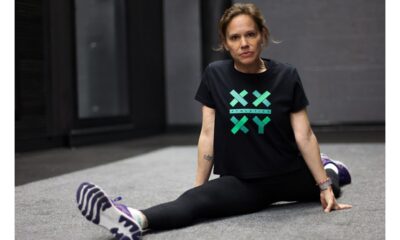Business
A $7.5-million find: Overlooked Getty estate sale map turns out to be 14th century treasure

Alex Clausen is a map dealer.
And although that designation may not, at first read, exude adventure and romance, Clausen really is a modern-day treasure hunter. He doesn’t sail the seas in search of sunken ships and pirate booty. But from his perch at Barry Lawrence Ruderman Antique Maps Inc. in La Jolla, he has made some impressive discoveries.
Clausen, 35, peruses auctions, estate sales and other dealers’ websites in search of antique maps, manuscripts and pivotal historical documents that have been forgotten or overlooked — sometimes for decades.
A few years ago, he got his hands on the original drawings for the Statue of Liberty. But nothing, he said, compares to the $7.5-million find he came across last fall.
Map dealer Alex Clausen said certain details on this portolan chart offered clues that it was far older than the 16th century date listed at the Getty estate sale.
(Robert Gauthier / Los Angeles Times)
Clausen was deep in a virtual tour of an estate sale for oil heir Gordon Getty and his wife, Ann, an avid collector who died in 2020. Tucked between a George II mahogany breakfront secretaire bookcase and a series of manuscript and watercolor maps showing the waterways of Venice, Clausen found a type of antiquated nautical map known as a portolan chart.
The chart, which the estate sale dated between 1500 and 1525, caught his eye: “It wasn’t like the chairs, lamps and things that surrounded it,” he said. The estimated price, between $100,000 and $150,000, seemed fitting for a portolan chart from the 16th century.
But something didn’t quite fit. The map seemed older.
What unfolded became “the best story of a portolan chart, at least in the United States, in the years I’ve been chasing this subject,” said Richard Pflederer, an independent scholar who specializes in the topic.
Portolan charts are hand-drawn seafaring maps, typically drafted on animal skin, that were used during early exploration for navigation between ports. They are known for distinctive rhumb lines that radiate out from various points in the ocean in the direction of wind or compass points to help navigators plot their course. They often feature drawings of compass roses, flags, sea monsters and ships; unlike modern maps, interior details of land are not the key focus.
Among map collectors, Clausen said, portolan charts hold a special mystique, because they offer insight into the very earliest forms of mapmaking.
“There’s no two portolans really from this early phase that are the same,” he said.

Clausen has made some impressive finds in his regular perusal of estate sales and auctions, but he says none compares to his discovery of a 14th century nautical map now listed for $7.5 million.
(Robert Gauthier / Los Angeles Times)
As Clausen examined the chart more closely via an online portal, the date just didn’t seem right. Granada in southeastern Spain was labeled with a different flag than the other Spanish kingdoms in the Iberian Peninsula. The detail that stuck out because Granada was home to the last holdout of the Moorish kingdom before surrendering to Spanish forces in 1492. That would place the map, at latest, in the 15th century and not the 16th.
But finding out the exact age — and how much the chart was truly worth — took Clausen on a months-long historical journey.
The first known reference to the chart came from Italian scholar Pietro Amat di San Filippo, who saw the map in the library of a Corsini family palace in Florence in 1888 and included mention of it in an article he wrote for the Italian Geographic Society. The scholar tentatively dated it from 1347 to 1354. It changed hands several times before Ann and Gordon Getty purchased it in 1993.
The couple had the map restored and for years it hung in the library of their San Francisco townhouse. They paid roughly 56,500 British pounds for the map, then the equivalent of about $85,000. Nearly 30 years later, Clausen and the team from Barry Lawrence Ruderman purchased it for just over $239,000.
It ended up being a steal.
“It was truly hidden in plain sight,” said Barry Ruderman, Clausen’s business partner.

Among map collectors, portolan charts hold a special mystique because they offer insight into the very earliest forms of mapmaking.
(Robert Gauthier / Los Angeles Times)
The chart extends from the islands of the North Atlantic Ocean to the Mongol empire’s Golden Horde in what is now Eastern Europe. In the west, it shows the borders of the kingdoms involved in the Hundred Years’ War, featuring the most complete mapping of the British Isles at that time. In the east, the chart shows the remnants of the Crusader strongholds and the final throes of the Byzantine Empire.
The clues initially led Clausen to suspect the map had been drawn around 1420. He consulted with scholars and catalogers, including Pflederer, carefully omitting his hypothesis about the date. After reviewing images of the map, a medievalist suggested it may date to the mid-1350s.
“I was just incredulous,” Clausen said of the revelation. “We were talking about something that really only exists in a handful of national libraries.”
There’s only so much that can be seen through high-resolution images online, so Clausen went to see the chart in New York before the sale. In particular, he wanted to get a better look at a portrait that Christie’s suggested was King Solomon. When he examined the map, he saw the figure was actually an homage to the 2nd century geographer Ptolemy.
The crowned and bearded man is pictured holding a compass to the nearby Atlas Mountains in North Africa. A Latin inscription next to him reads “In this mountain range, King Ptolemaeus uses a world-compass and through astrology, by longitudes and by latitudes, he constructed a mappa mundi and a cosmography.”
Clausen believes the chart’s author conflated Ptolemy with a dynasty of Greek kings who had ruled Egypt.
After the chart was purchased, Clausen sent it to a lab in New York that took a scientific approach to dating, analyzing pigments and performing carbon dating on a small piece of the parchment. Through their tests, they determined the chart was created, on the early end, from the 1320s to the 1350s; and at latest from the 1390s to the 1420s.
By the time the artifact made it to San Diego, Clausen and his team had found scholarly articles dating to the 1880s that suggested the chart was created in the mid-1300s. After hundreds of hours of research they finally had a date: 1360.
Making the discovery “was really rewarding from an intellectual perspective,” Clausen said, surveying the chart, which measures roughly 2.2 feet by 3.7 feet and is framed in a heavy case at his office in La Jolla.
“And, of course, it’s also rewarding from a commercial perspective, because it takes something that I think was a reasonable buy from what it was listed as and moves it into an absolutely different category.”
The Barry Lawrence Ruderman antique map shop is listing the chart, now dubbed the Rex Tholomeus Portolan Chart of 1360, for $7.5 million. With such a price tag, it probably won’t attract a novice map collector. Instead, Clausen envisions a university or museum taking ownership and placing it somewhere that people can enjoy and learn from it.
The chart is the only complete 14th century portolan known to exist outside Europe. Although not the oldest portolan in existence, it is “an important data point in understanding the evolution of European cartography of the Mediterranean Sea and adjacent waters,” Pflederer said.
And it’s older than portolans displayed by the Huntington Library in San Marino, the Morgan Library and Museum in New York, the Newberry Library in Chicago and the Beinecke Rare Book and Manuscript Library at Yale University.
“It’s a bit of an Indiana Jones thing,” Ruderman, Clausen’s business partner, said of the experience.
“After over 30 years in the business, the greatest thrills are the discoveries which are truly unexpected, but for which you search and prepare your entire career. You don’t know where or when, you simply prepare for the journey.”

Business
Delaying Medicare enrollment. What to know

Dear Liz: When my husband was approaching 65, he was employed and covered by a high-deductible healthcare plan with a health savings account by his employer. Neither his employer nor our local Social Security office had concrete advice on how to proceed about enrolling in Medicare, but after tremendous research, he eventually delayed enrollment. Now I am approaching 65. My husband is still working, and I am still covered by his health insurance, although both are in his name. Do I enroll in Medicare at the appropriate time or do I delay enrollment like he did?
Answer: Delaying Medicare enrollment can result in penalties that can increase your premiums for life. If you or a spouse is still working for an employer with 20 or more employees, however, generally you can opt to keep the employer-provided health insurance and delay applying for Medicare without being penalized. If you lose the coverage or employment ends, you’ll have eight months to sign up before being penalized.
Delaying your Medicare enrollment also allows your husband to continue making contributions on your behalf to his health savings account. In 2025, the HSA contribution limit is $4,300 for self-only coverage and $8,550 for family coverage, plus a $1,000 catch-up contribution for account holders 55 and older. Once you enroll in Medicare, HSA contributions are no longer allowed.
Medicare itself suggests reaching out to the employer’s benefits department to confirm you are appropriately covered and can delay your application. Let’s hope that by now your employer’s human resources department has gotten up to speed on this important topic.
Dear Liz: We read your recent column about capital gains and home sales. Our understanding is that if you sell and then buy a property of equal or greater value within the 180-day window, the basis for tax purposes is the purchase price, plus the $500,000 exemption, plus the improvements to the property, minus the depreciation, whatever that number comes to, and then the profit above that has to be reinvested or it is subject to capital gains. We talked to our CPA about this and he referred us to a site that specializes in 1031 exchanges.
Answer: You’ve mashed together two different sets of tax laws.
Only the sale of your primary residence will qualify for the home sale exemption, which for a married couple can exempt as much as $500,000 of home sale profits from taxation. You must have owned and lived in the home at least two of the previous five years.
Meanwhile, 1031 exchanges allow you to defer capital gains on investment property, such as commercial or rental real estate, as long as you purchase a similar property within 180 days (and follow a bunch of other rules). The replacement property doesn’t have to be more expensive, but if it’s less expensive or has a smaller mortgage than the property you sell, you could owe capital gains taxes on the difference.
It is possible to use both tax laws on the same property, but not simultaneously.
In the past, you could do a 1031 exchange and then convert the rental property into a primary residence to claim the home sale exemption after two years. Current tax law requires waiting at least five years after a 1031 exchange before a home sale exemption can be taken.
You can turn your primary residence into a rental and after two years do a 1031 exchange, but you would be deferring capital gains, while the home sale exemption allows you to avoid them on up to $500,000 of home sale profits.
Liz Weston, Certified Financial Planner, is a personal finance columnist. Questions may be sent to her at 3940 Laurel Canyon, No. 238, Studio City, CA 91604, or by using the “Contact” form at asklizweston.com.
Business
LinkedIn cuts 281 workers in California as tech layoffs continue

LinkedIn, the professional social network where people search for work, is shedding jobs.
The Microsoft-owned tech company has cut 281 workers in California, a notice filed this week to the California Employment Development Department shows.
Earlier this month, Microsoft said that it was terminating 3% of staff, or about 6,000 workers. The layoffs affected its California employees and LinkedIn workers.
LinkedIn is among major tech companies that have slashed their workforces this year. Meta, Google, Autodesk and other tech companies have also been cutting workers, citing various reasons, including restructuring, investments in artificial intelligence and low worker performance.
LinkedIn, headquartered in Sunnyvale and Mountain View, notified its employees about the layoffs on May 13. Workers posted about their pink slips on the social network, letting hiring managers and recruiters know that they were open to work.
The company didn’t respond to a request for comment. Its website says it has roughly 18,400 employees and offices in more than 30 cities globally.
LinkedIn’s California layoffs affected workers at its offices in San Francisco, Mountain View, Carpinteria and Sunnyvale. More than half of those cuts hit its workforce in Mountain View.
Software engineers were heavily impacted by LinkedIn’s California layoffs, according to data provided to the state. Talent account directors, senior product managers and other workers also lost their jobs.
The cuts come as tech companies are releasing more artificial intelligence-powered tools that can generate code. Executives have also said that would impact engineering jobs.
Microsoft Chief Executive Satya Nadella said in April that as much as 30% of the company’s code is written by AI. Nadella spoke during a conversation with Meta Chief Executive Mark Zuckerberg at the social network’s AI developer conference.
As Microsoft competes to release more AI tools, the company has said that it’s trying to increase how fast it moves by reducing the number of managers and cutting down on redundancies.
It’s the latest cost-cutting round at LinkedIn. In 2023, the company laid off nearly 700 employees and said that it was trying to improve agility and accountability as part of a reorganization effort.
Microsoft purchased LinkedIn for $26 billion in 2016. In April, the company reported that its revenue in the third fiscal year quarter reached $4.3 billion in the third fiscal year quarter, up 7% over last year.
Business
FCC commissioner sounds alarms about free speech 'chilling effect' under Trump

Federal Communications Commissioner Anna M. Gomez traveled to Los Angeles this week to sound an alarm that attacks on the media by President Trump and his lieutenants could fray the fabric of the 1st Amendment.
Gomez’s appearance Wednesday at Cal State L.A. was designed to take feedback from community members about the changed media atmosphere since Trump returned to office. The president initially expelled Associated Press journalists from the White House, for example. He signed an executive order demanding government funding be cut to PBS and NPR stations.
Should that order take effect, Pasadena-based radio station LAist would lose nearly $1.7 million — or about 4% of its annual budget, according to Alejandra Santamaria, chief executive of parent organization Southern California Public Radio.
“The point of all these actions is to chill speech,” Gomez told the small crowd. “We all need to understand what is happening and we need people to speak up and push back.”
Congress in the 1930s designed the FCC as an independent body, she said, rather than one beholden to the president.
But those lines have blurred. In the closing days of last fall’s presidential campaign, Trump sued CBS and “60 Minutes” over edits to an interview with then-Vice President Kamala Harris, alleging producers doctored the broadcast to enhance her election chances. CBS has denied the allegations and the raw footage showed Harris was accurately quoted.
Trump-appointed FCC Chairman Brendan Carr, upon taking office in January, revived three complaints of bias against ABC, NBC and CBS, including one alleging the “60 Minutes” edits had violated rules against news distortion. He demanded that CBS release the unedited footage.
The FCC’s review of Skydance Media’s pending takeover of CBS-parent Paramount Global has been clouded by the president’s $20-billion lawsuit against CBS. The president rejected Paramount’s offer to settle for $15 million, according to the Wall Street Journal, which said Trump has demanded more.
Two high-level CBS News executives involved in “60 Minutes” were forced out this spring.
Gomez, in an interview, declined to discuss the FCC’s review of the Skydance-Paramount deal beyond saying: “It would be entirely inappropriate to consider the complaint against the ’60 Minutes’ segment as part of a transaction review.” Scrutinizing edits to a national newscast “are not part of the public interest analysis that the commission does when it considers mergers and acquisitions,” she said.
For months, Gomez has been the lone voice of dissent at the FCC. Next month, she will become the sole Democrat on the panel.
The longtime communications attorney, who was appointed to the commission in 2023 by former President Biden, has openly challenged her colleague Carr and his policies that align with Trump’s directives. She maintains that some of Carr’s proposals, including opening investigations into diversity and inclusion policies at Walt Disney Co. and Comcast, go beyond the scope of the FCC, which is designed to regulate radio and TV stations and others that use the public airwaves.
The pressure campaign is working, Gomez said.
“When you see corporate parents of news providers … telling their broadcasters to tone down their criticisms of this administration, or to push out the executive producer of ’60 Minutes’ or the head of [CBS] News because of concerns about retribution from this administration because of corporate transactions — that is a chilling effect,” Gomez said.
Wednesday’s forum, organized by the nonprofit advocacy group Free Press, was punctuated with pleas from professors, journalists and community advocates for help in fending off Trump’s attacks. One journalist said she lost her job this spring at Voice of America after Trump took aim at the organization, which was founded more than 80 years ago to counter Nazi propaganda during World War II.
The Voice of America’s remaining staffers could receive reduction-in-force notices later this week, according to Politico.
Latino journalists spoke about the difficulty of covering some stories because people have been frightened into silence due to the administration’s immigration crackdown.
For now, journalists are able to carry out their missions “for the most part,” said Gabriel Lerner, editor emeritus of the Spanish-language La Opinión.
But he added a warning.
“Many think that America is so exceptional that you don’t have to do anything because fascism will never happen here,” Lerner said. “I compare that with those who dance on the Titanic thinking it will never sink.”
The White House pushed back on such narratives:
“President Trump is leading the most transparent administration in history. He regularly takes questions from the media, communicates directly to the public, and signed an Executive Order to protect free speech on his first day back in office,” spokesperson Anna Kelly said. “He will continue to fight against censorship while evaluating all federal spending to identify waste, fraud, and abuse.”
FCC Commission Chairman Brendan Carr on Capitol Hill.
(Alex Wroblewski / Bloomberg via Getty Images)
Traditionally, the five-member FCC has maintained an ideological balance with three commissioners from the party in power and two from the minority. But the senior Democrat — Geoffrey Starks — plans to step down next month, which will leave just three commissioners: Gomez, Carr and another Republican, Nathan Simington.
Trump has nominated a third Republican, Olivia Trusty, but the Senate has not confirmed her appointment.
Trump has not named a Democrat to replace Starks.
Some on Wednesday expressed concern that Gomez’s five-year tenure on the commission could be cut short. Trump has fired Democrats from other independent bodies, including the Federal Trade Commission and the Consumer Product Safety Commission.
Gomez said if she is pushed out, it would only be because she was doing her job, which she said was defending the Constitution.
Rep. Raul Ruiz (D-Indio) applauded Gomez’s efforts and noted that he’s long appreciated coordinating with her on more routine FCC matters, such as ensuring wider broadband internet access.
“But now the fight is the survival of the free press,” Ruiz said.
He noted that millions of people now get news from non-journalist sources, leading to a rise of misinformation and confusion.
“What is the truth?” Ruiz said. “How can we begin to have a debate? How can we begin to create policy on problems when we can’t even agree on what reality is?”
-

 News1 week ago
News1 week agoRead the Full ‘Make America Healthy Again’ Report
-
Movie Reviews1 week ago
Movie Review: 'Pee-wee as Himself' unmasks Paul Reubens
-

 Technology1 week ago
Technology1 week agoNow you can watch the Internet Archive preserve documents in real time
-

 World1 week ago
World1 week agoNeo-Nazi cult leader extradited to US for plot to kill Jewish children
-

 Technology1 week ago
Technology1 week agoDiscord might use AI to help you catch up on conversations
-

 Movie Reviews1 week ago
Movie Reviews1 week agoMovie review: 'Dogma' re-release highlights thoughtful script – UPI.com
-

 Business1 week ago
Business1 week agoPlastic Spoons, Umbrellas, Violins: A Guide to What Americans Buy From China
-

 Science1 week ago
Science1 week agoTrump Has Cut Science Funding to Its Lowest Level in Decades




















